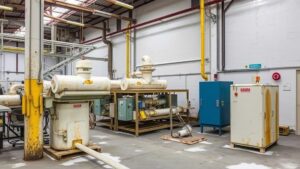Exploring Abandoned Cotton Compress Stations for Forgotten Equipment
Exploring Abandoned Cotton Compress Stations for Forgotten Equipment
The cotton industry has played a pivotal role in the economic development of numerous regions, particularly in the Southern United States. As one of the major commodities in the late 19th and early 20th centuries, cotton compress stations were instrumental in the storage and processing of cotton bales before shipping them to markets. But, many of these facilities have been abandoned over the years. This research article aims to explore these forgotten sites and the equipment they house, highlighting their historical significance and the potential for rediscovery and preservation.
Historical Context of Cotton Compress Stations
Cotton compress stations emerged in response to the burgeoning cotton industry, particularly between 1865 and 1930. The rise of these facilities coincided with the expansion of the railroads, which provided an efficient means for transporting cotton from rural farms to urban markets. Key states involved in this development included Texas, Mississippi, and Georgia, where numerous compress stations were established.
By the mid-20th century, the cotton industry began to face challenges due to changing agricultural practices and increased global competition. As a result, many of the compress stations became obsolete, leading to neglect and abandonment. For example, the Delta Compress Company in Greenwood, Mississippi, which once processed thousands of bales annually, has been largely inoperative since the 1990s.
The Equipment: A Wealth of Forgotten Technology
Abandoned cotton compress stations are often filled with technological artifacts that reflect the past industrial practices of cotton processing. Equipment such as hydraulic presses, automatic bale strappers, and conveyor belts can often be found rusting and decaying in these facilities.
Some notable pieces of equipment include:
- Hydraulic Compresses: These machines were designed to compact cotton–reducing the volume of bales for more economical transport. can weigh several tons and feature complex hydraulic systems once considered cutting-edge.
- Bale Strappers: Automated strapping machines were developed to help securely bind bales for easier handling and shipping. Their intricate mechanisms highlight the engineering capabilities of their time.
- Weighing Scales: Heavy-duty scales were used both to measure the weight of cotton bales and to determine market value. These scales serve as a physical reminder of the economic impact of the cotton trade.
The Cultural and Economic Significance of Restoration
Restoring abandoned cotton compress stations offers both cultural and economic opportunities. e sites serve as historical landmarks that represent the agricultural heritage of the regions they inhabit. Plus, there is a growing trend in heritage tourism which can benefit local economies. For example, the effort to restore the former Memphis Compress Company in Tennessee led to its transformation into a cultural venue, helping preserve local history while driving economic growth.
From an economic perspective, revitalizing these sites can also provide job opportunities related to restoration efforts and tourism management. According to the National Trust for Historic Preservation, heritage tourism generates approximately $192 billion annually in the United States, underscoring the financial potential of reviving abandoned sites.
Challenges to Preservation
While exploring and restoring cotton compress stations is an intriguing venture, challenges abound. Preservation efforts often face issues such as funding difficulties, environmental regulations, and the physical instability of aging structures. For example, in Alabama, the site of the former Montgomery Compress was complicated by legal hurdles that delayed restoration efforts, illustrating the multifaceted challenges that local advocates may encounter.
Potential for Future Research and Rediscovery
Future research related to abandoned cotton compress stations can focus on the historical documentation of these sites, including archival research that traces their operational timelines and impacts on local economies. Also, archaeological studies can uncover artifacts linked to the areas social and economic history, providing insight into community dynamics and labor practices during cotton processings peak years.
Technological advancements, such as 3D scanning, can also be employed to create digital models of remaining equipment, offering educational resources without the need for invasive exploration.
Conclusion
To wrap up, abandoned cotton compress stations serve as a powerful reminder of the economic and cultural history tied to the cotton industry. The equipment housed within these stations not only encapsulates the technological advances of the time but also speaks to the lives and labor of those who worked within them. Through efforts toward preservation and restoration, communities can reclaim these sites, transforming them into educational and economic assets for future generations.
Actionable Takeaways
- Engage local historical societies to initiate documentation of abandoned cotton compress stations.
- Explore partnerships with cultural heritage organizations to fund preservation efforts.
- Use technology to create digital libraries of the equipment and history for public access.
- Encourage community involvement in heritage tourism initiatives to foster awareness and support for restoration projects.



